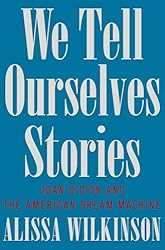 Joan Didion as a Screenplay
Joan Didion as a Screenplay
A Review of
We Tell Ourselves Stories: Joan Didion and the American Dream Machine
Alissa Wilkinson
Hardcover: Liveright, 2025
Buy Now: [ Bookshop ] [ Amazon ] [ Kindle ] [ Audible ]
Reviewed by Amy Neftzger
The title of Alissa Wilkinson’s new book tells us exactly what she’s writing about, but Joan Didion’s famous quote holds more subtext than initial reading might suggest, and Wilkinson fully explores it. Most people who read Didion’s famous phrase “We tell ourselves stories in order to live” interpret it as a tribute to how storytelling can enrich our lives. However, Didion was suggesting that we strive to organize events into meaning as more of a defense mechanism. In Wilkinson’s analysis, she explores how stories, movies, culture, and politics are intertwined in America.
Throughout the book Wilkinson references Didion’s idolization of John Wayne. In context of her identity as a descendent of pioneers and rugged survivors, it makes sense that Joan would admire someone like him. Over time, however, the film industry and Joan evolved. Although she continued to admire John Wayne until the end of her life, Joan doesn’t appear to embrace the values he stood for in quite the same manner. Times were changing, and Wilkinson follows Didion’s life through these evolutions as she draws parallels between the movie industry, society, and the stories Joan told herself about who she was.
For example, the 1960s were a pivotal time. Films moved away from escapism and towards action and chaos. Films centered on stories about people living on the edge of society who connect with others who also feel like outsiders. The stories reflect the paranoia of the time to include conspiracy theories, but these eventually evolved into the disaster films of the 1970s. Hollywood was producing narratives in which people saw themselves and the world. Although these stories may begin as a mirror reflecting culture, they ultimately changed the way people think so that the mirror becomes reality. As a screenwriter, Joan saw how the projection of narratives found a way into politics where it mattered less who the person was than how the person was perceived. This was alarming to Joan, and it caused a shift in her political ideology.
Wilkinson tracks Joan’s evolution from a young conservative to someone with much more liberal views. The book also details how Joan saw the current division between political parties as a product of the entertainment leaning news shows which began in the 1980s. Television of this sort engages viewers as fans invested in storylines and characters rather than observing facts or evaluating policies. The blurring of lines between fact and fiction was something Joan found concerning. In her opinion, people told themselves stories to avoid facing the reality of a world they didn’t like rather than search for ways to change it.
Joan interpreted the wave of superhero films as America’s fantasy for better control over the uncontrollable. The idea that everything can be manipulated may be appealing, but it leaves little room for some of the most basic human experiences. Control, Joan wrote, is “an illusion, an error we learn through life to relinquish.” Not having control can turn into an opportunity for personal growth and connect us more deeply with other humans. Wilkinson sums up her interpretation of Joan’s famous quote as follows: “In order to survive the chaos and randomness of the universe, we make up stories that explain why things happen, or give meaning to what ultimately has none.”
While Wilkinson doesn’t dive deep into Joan’s childhood or other life events, she does draw parallels to movies in several of them, such as the resemblance of Joan’s wedding to scenes from Vertigo. The book provides a rich understanding of Joan as a cultural icon, and there’s much we can learn from Joan’s life by reading it. We’re surrounded by stories, whether we acknowledge them or not. Governments make up stories to prevent the public from worrying. Politicians often tell stories based more on feeling than fact because feelings are universal and can be easily identified with. People who can identify with you will vote for you, because it’s like voting for themselves. Gilding the past to make it more appealing can prevent people from facing the present with a sense of reality. Mythology can be intoxicating, causing us to yearn for things we think we miss but which might have never existed.
While this book is not a comprehensive biography of Joan Didion, it explores her relevance to American culture and her ability to clearly see the process of the myth making machines within it. It also shows how Joan and her work are still relevant. Joan Didion was a novelist, a screenwriter, a movie and book critic, a wife, a mother, a widow, a celebrity, a conservative, a liberal, a New Yorker, a Californian, and an American. She was both part of the Hollywood machine and a product of it. Like America, she contained contradictions that can only be understood within context, much like a good screenplay.

Amy Neftzger
Amy Neftzger has been writing books and articles for over 20 years. Her works include non-fiction, professional articles and several fiction books, such as The Ferryman. Some of her favorite things include traveling, books, movies, art and gargoyles.
 Reading for the Common Good From ERB Editor Christopher Smith "This book will inspire, motivate and challenge anyone who cares a whit about the written word, the world of ideas, the shape of our communities and the life of the church." -Karen Swallow Prior Enter your email below to sign up for our weekly newsletter & download your FREE copy of this ebook! |
 Understanding Christian Nationalism [A Reading Guide]
Understanding Christian Nationalism [A Reading Guide] |
 Most Anticipated Books of the Fall for Christian Readers! Most Anticipated Books of the Fall for Christian Readers!
|
 Hilarious One-Star Customer Reviews of Bibles Hilarious One-Star Customer Reviews of Bibles |



![Nathaniel Samuel - When Stories Wound [Feature Review] Book Review (3)](https://englewoodreview.org/wp-content/uploads/2025/05/Book-Review-3.jpg)
![Tim Vivian - The Sayings and Stories of the Desert Fathers and Mothers [Review] Sayings-and-Stories-of-the-Desert-Fathers-and-Mothers](https://englewoodreview.org/wp-content/uploads/2024/02/Sayings-and-Stories-of-the-Desert-Fathers-and-Mothers.jpeg)


















